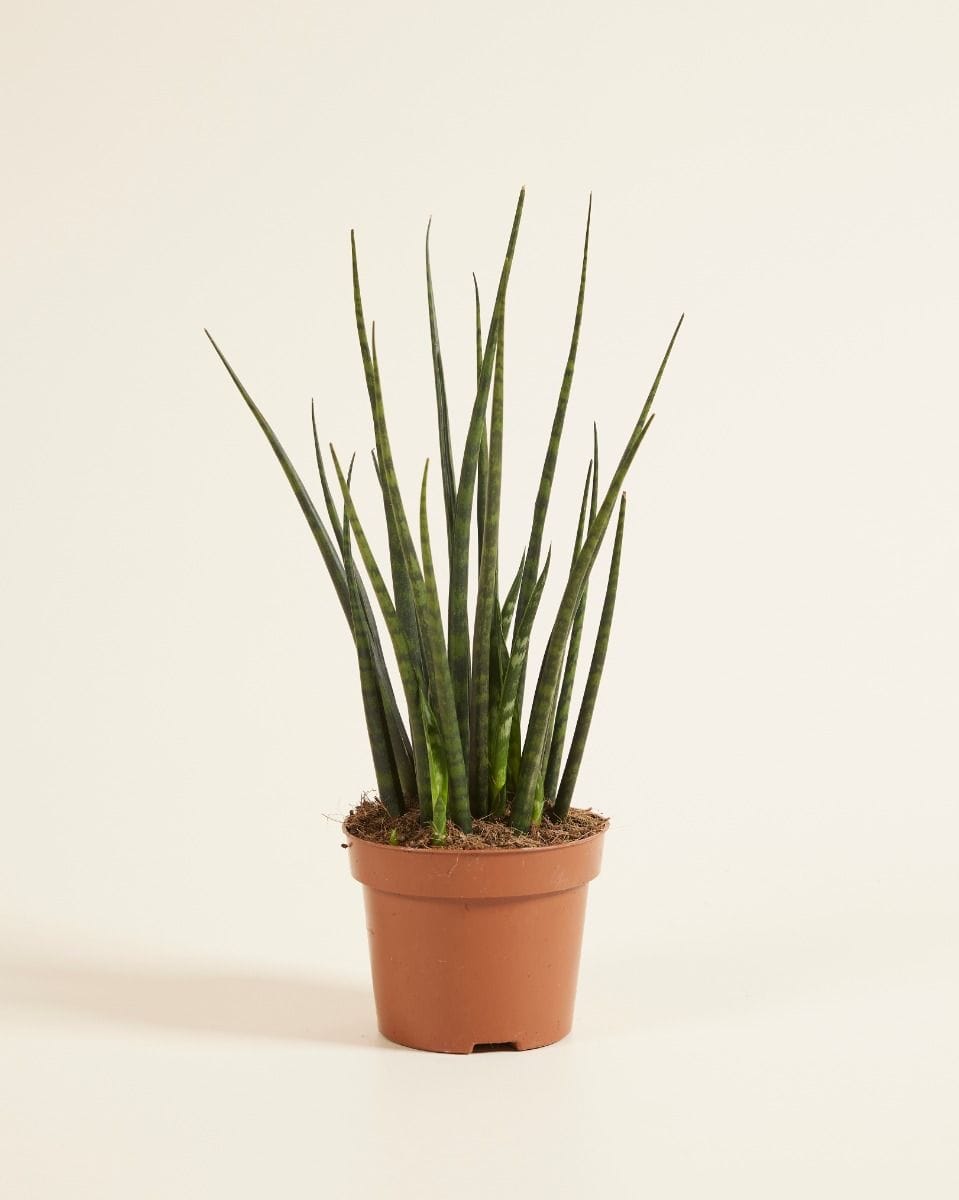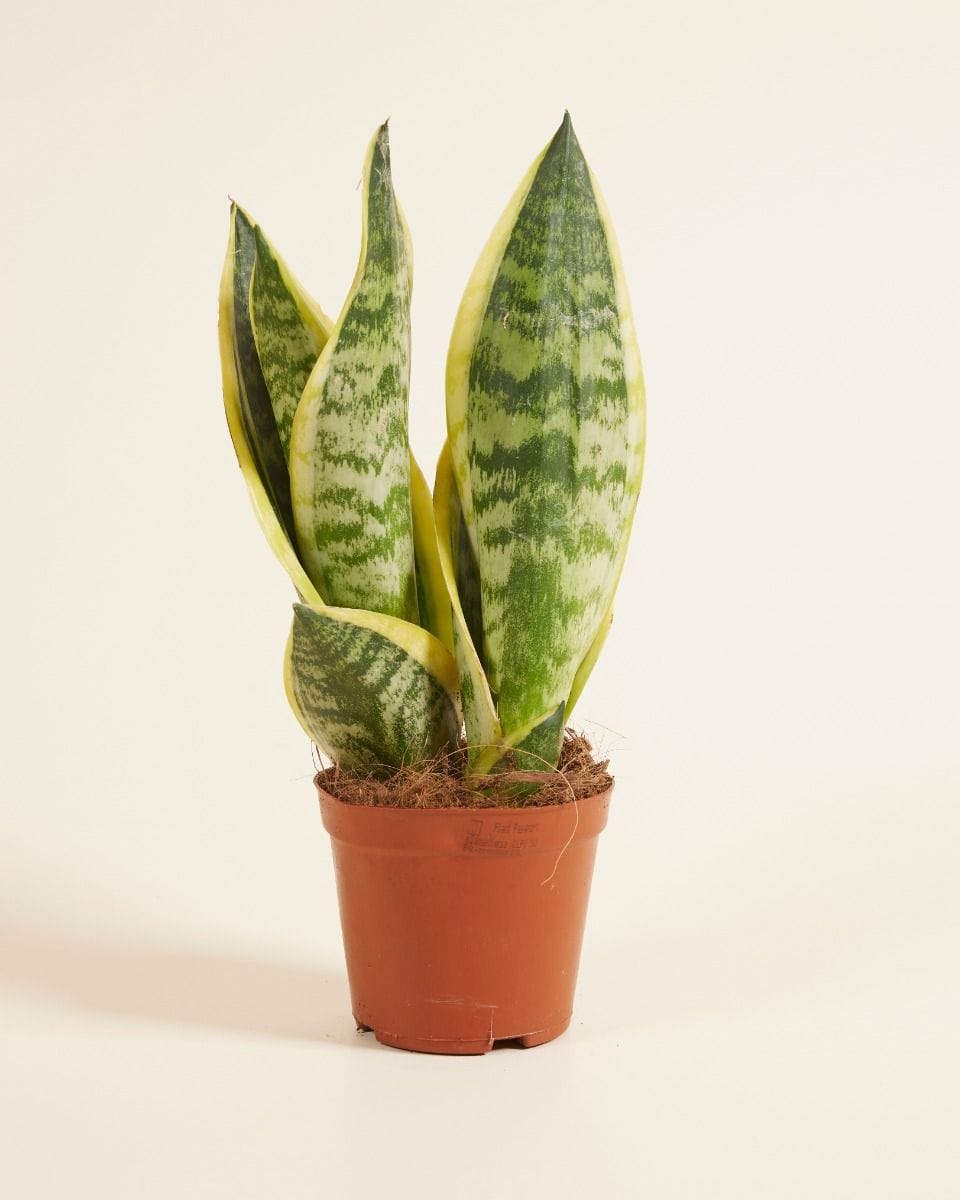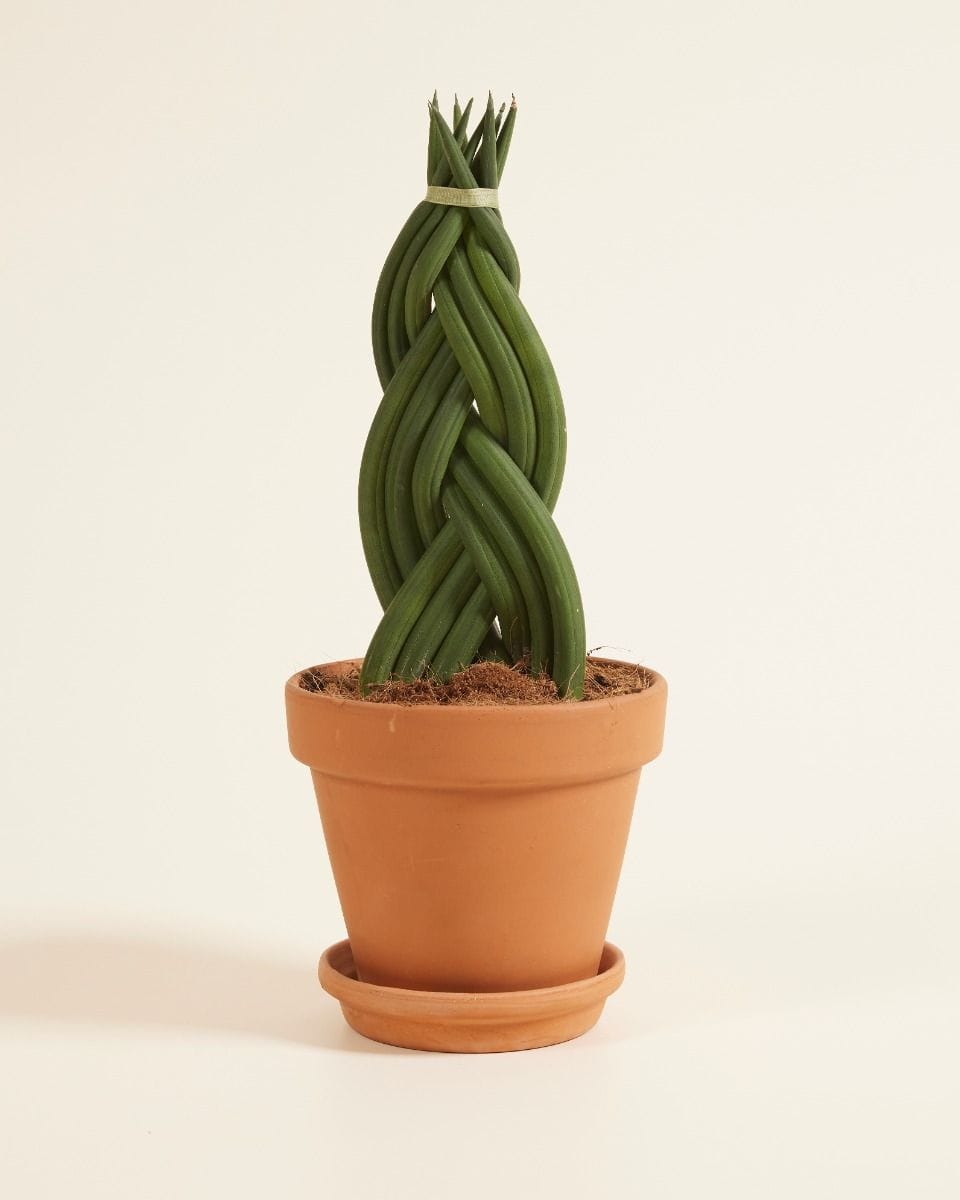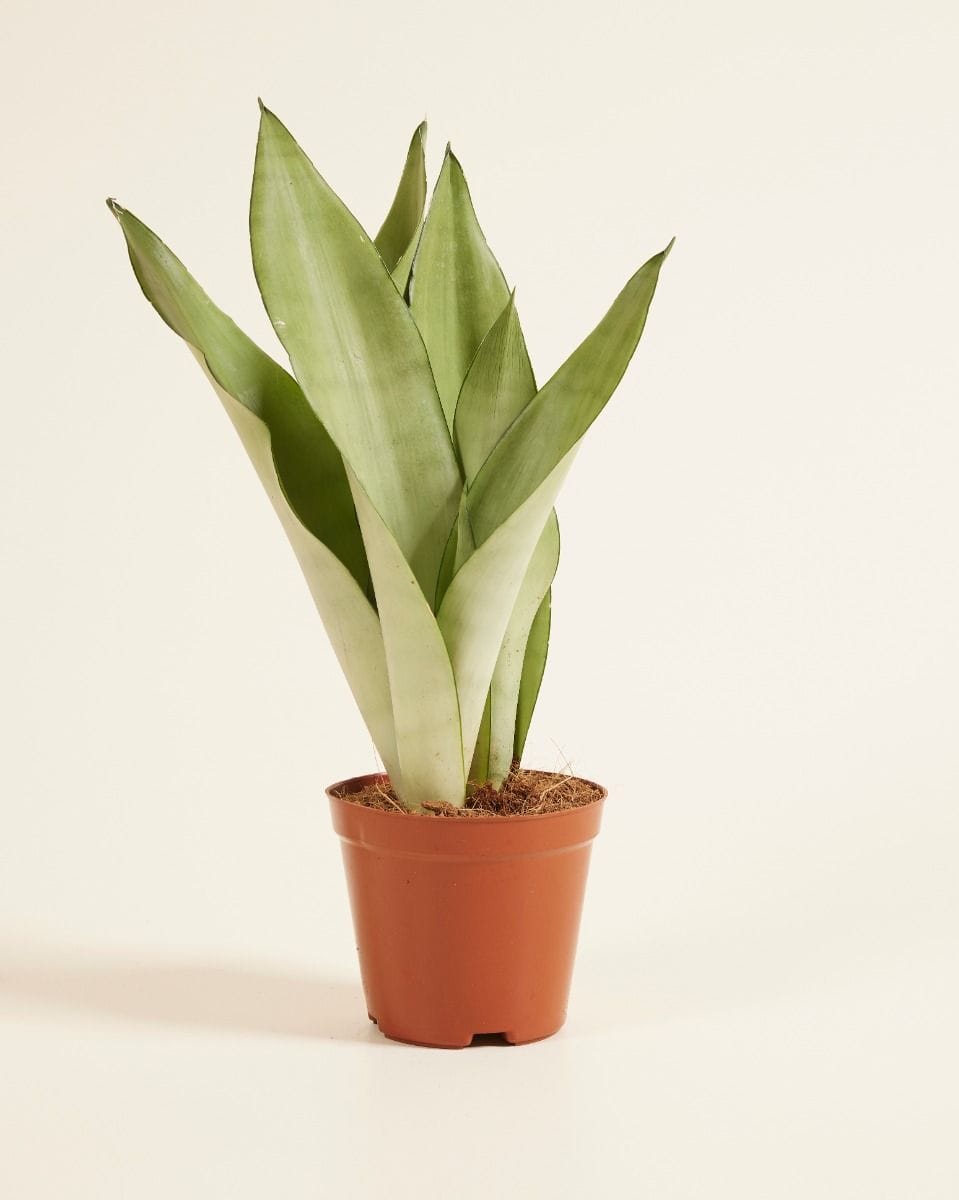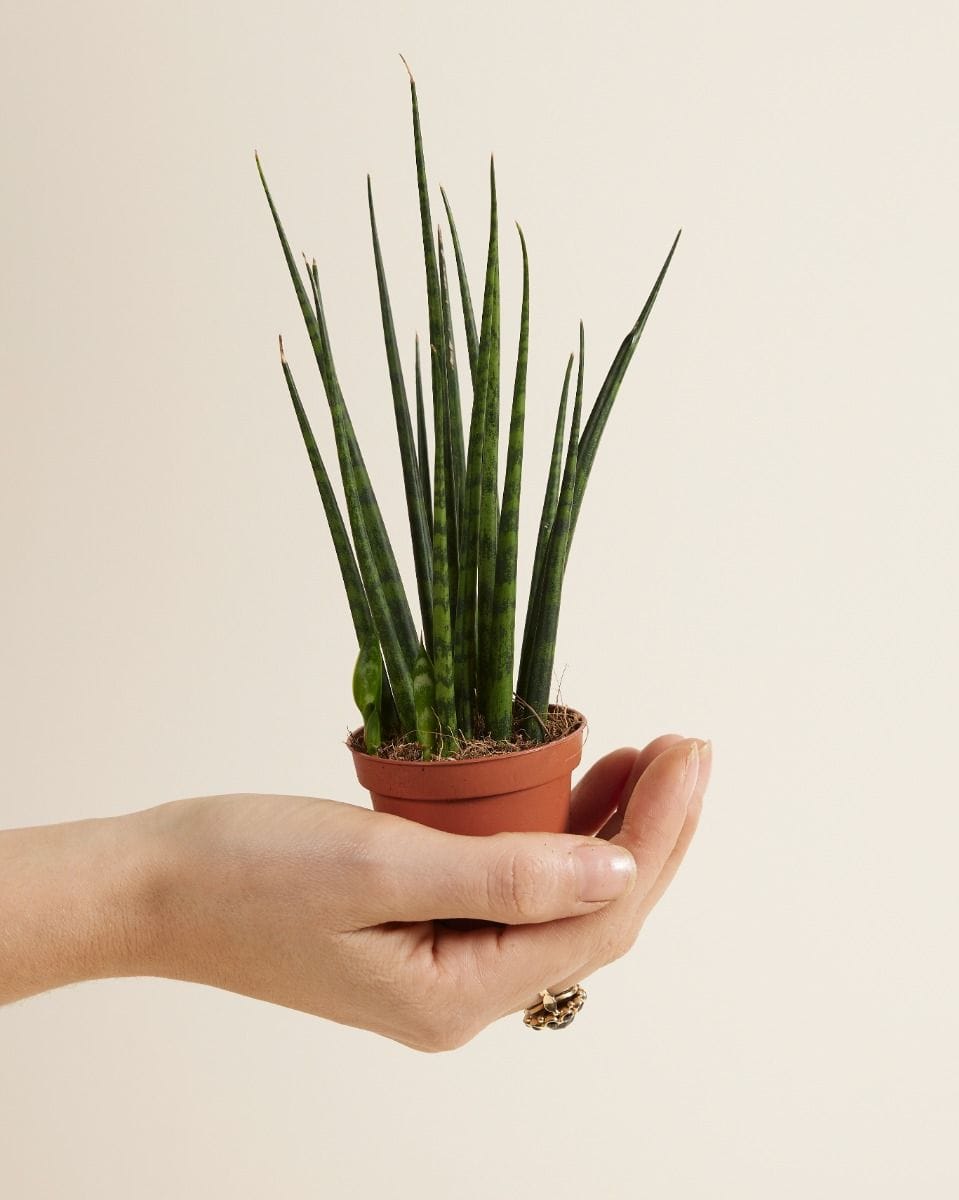In this article
- 1 How to care for Snake Plant (Sansevieria): Expert Tips for Thriving Plants
- 1.1 Snake Plant (Sansevieria) Care: 10 expert tips for growing it successfully
- 1.2 Snake Plant (Sansevieria) Care Tips
- 1.2.1 Light and placement
- 1.2.2 Water
- 1.2.3 Fertiliser
- 1.2.4 Temperature
- 1.2.5 Humidity
- 1.2.6 Repotting
- 1.2.7 Soil
- 1.3 Snake Plant Propagation
- 1.4 Most common pests and diseases on Sansevieria
- 1.5 Buy your new Sansevieria at PLNTS.com
How to care for Snake Plant (Sansevieria): Expert Tips for Thriving Plants
Sansevierias are among the most popular and well-known houseplants worldwide. They are also recognised by the names Snake Plant, Mother in Law's Tongue, Bowstring Hemp Plantor Devil’s Tongue. There are many species and varieties to choose from. The most common ones have distinctive sword-like leaves that grow upright or in rosettes.
Plant enthusiasts love Snake Plants because they are so easy to maintain. It can grow in low light and even survive without water for a while, making it an ideal plant for busy people or people who don't have perfect plant growing skills.
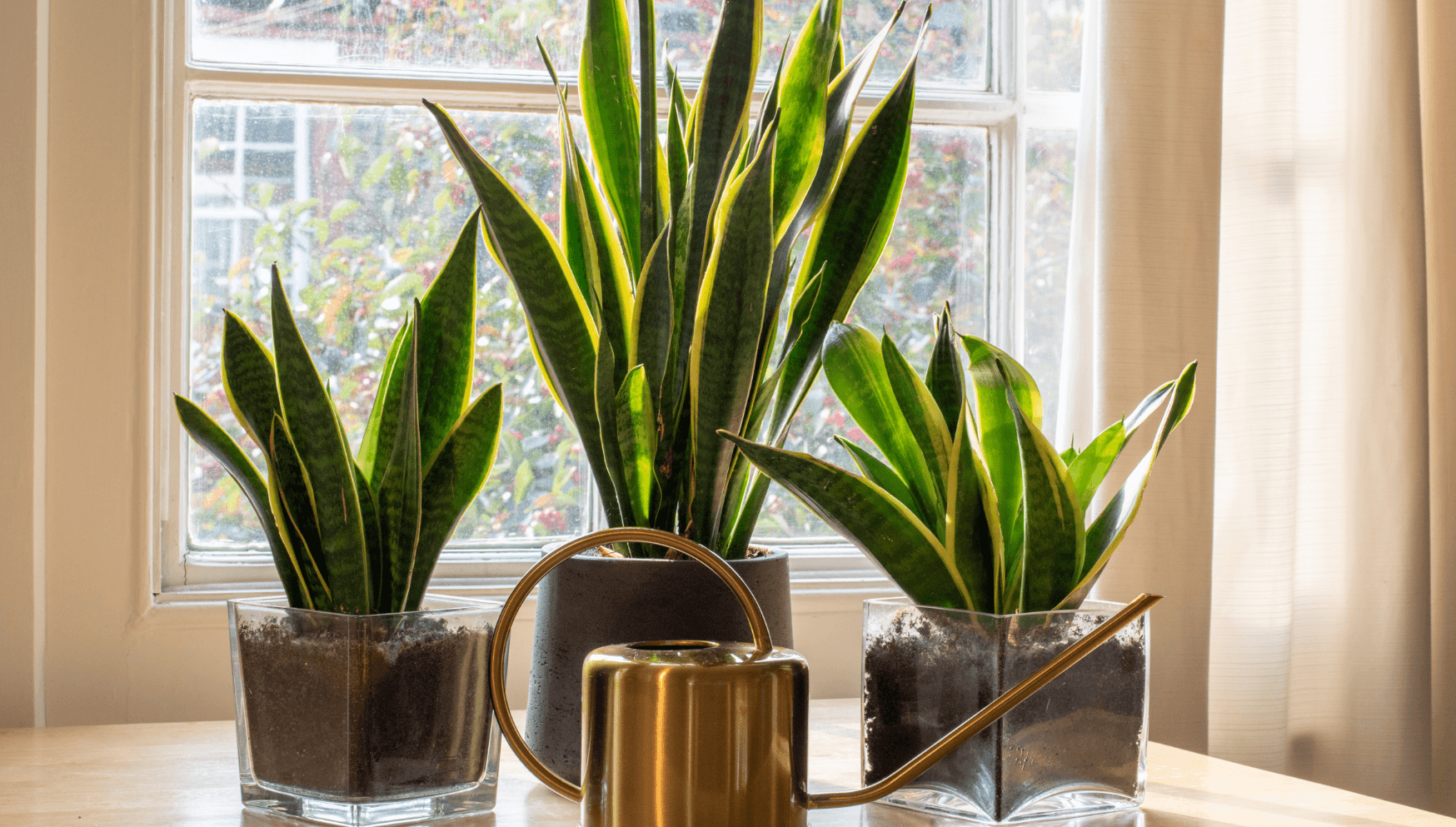
A fun fact about the Sansevieria! A study examined how space station air can be cleaned and filtered. It turned out that a number of plants can naturally remove toxic substances from the air. The Sansevieria was one of the top performers! So, Snake Plant is an excellent example of how plants can improve the air around you and even help you sleep better. Special, right?
Throughout this article, we will discuss everything you need to know about caring for Snake Plants.
Snake Plant (Sansevieria) Care: 10 expert tips for growing it successfully
- Let it dry out completely between waterings. Snake Plants are sensitive to overwatering and don't need as frequent watering as regular leafy houseplants.
- In shadier areas, it needs even less water. It will use less water and be less active than if it were in a bright light spot. Furthermore, soil in the shade will dry out slowlier.
- Water less in winter. In the same way as the previous point, the soil will take longer to dry out when days are shorter and the plant is dormant.
- It can tolerate low light very well. This makes it a wonderful houseplant for a shadier corner. However, you should avoid areas that have no light at all.
- Keep away from direct sunlight. If the leaves are exposed to too much sunlight, they may be burned and discoloured.
- Fertilisation is optional and not required. Even though it will benefit from the occasional application of diluted fertiliser during the growing season.
- Make sure the soil drains well. This is very important in order to prevent the roots from rotting due to overwatering. Avoid too compacted soil as well.
- Make sure the nursery pot has proper drainage holes. As a result, excess water escapes from the pot and does not remain around the plant's roots.
- Don't rush into repotting it to a larger pot too soon, as it thrives in a slightly rootbound pot.
- Occasionally clean its leaves. You can simply wipe away dust and debris with a damp cloth. Photosynthesis will be encouraged, and leaves will look healthier.
Snake Plant (Sansevieria) Care Tips
Light and placement
There's no doubt that Snake Plants are super tolerant of different lighting environments. They do better in low-light environments than any other houseplant, as they do not need much light to thrive. Therefore, a shadier spot in your home or office will be ideal for it.
However, they really grow best in medium to bright indirect light, that is filtered sunlight. In too low light conditions, their growth may stunt. It is also likely for those beautiful patterns to fade in shadier areas. In general, they are fine and don't complain.
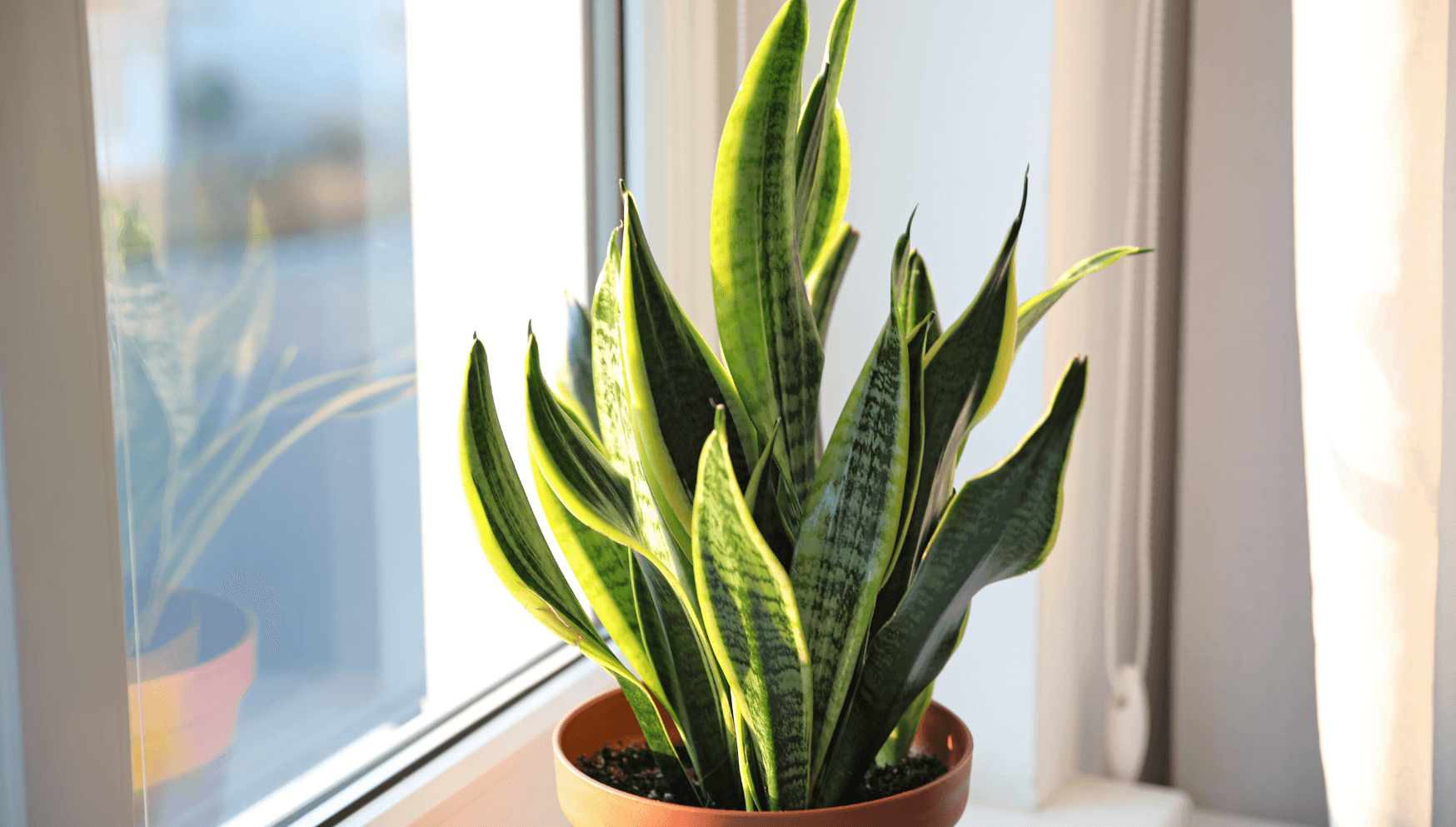
Good to know! Snake Plants are often placed in a dark room or corner, and while they can live there for a while (up to half a year), they gradually start to yellow and die because they can't photosynthesise.
While Snake Plants naturally tolerate direct sunlight, nursery-grown Sansevierias are more sensitive. Even so, a few hours of morning or afternoon sun will enhance the vivid colours on the leaves.
Water
The most important thing to know is that you can only water a Sansevieria wrongly if you water too much. It is crucial to water your Snake Plants only when the soil ball has dried out completely. If you water it too often, the chance that root rot will occur and that the plant will die is big.
Make sure your soil isn't wet by touching it from the top and bottom (through drainage holes), or you can use a water meter to measure soil moisture. There are times when the lower part of the soil will dry out slower than the upper part.
Good to know! Plants like Snake Plants can tolerate drought for months without complaining, making them a great choice for someone who forgets to water their plants.
Snake Plants will grow and dry out more slowly in a low-light environment, so you will have to water them less often. Winter will also require less watering because the days will be shorter, and the soil will dry out more slowly. Hence, you probably shouldn't water it more than once a month.
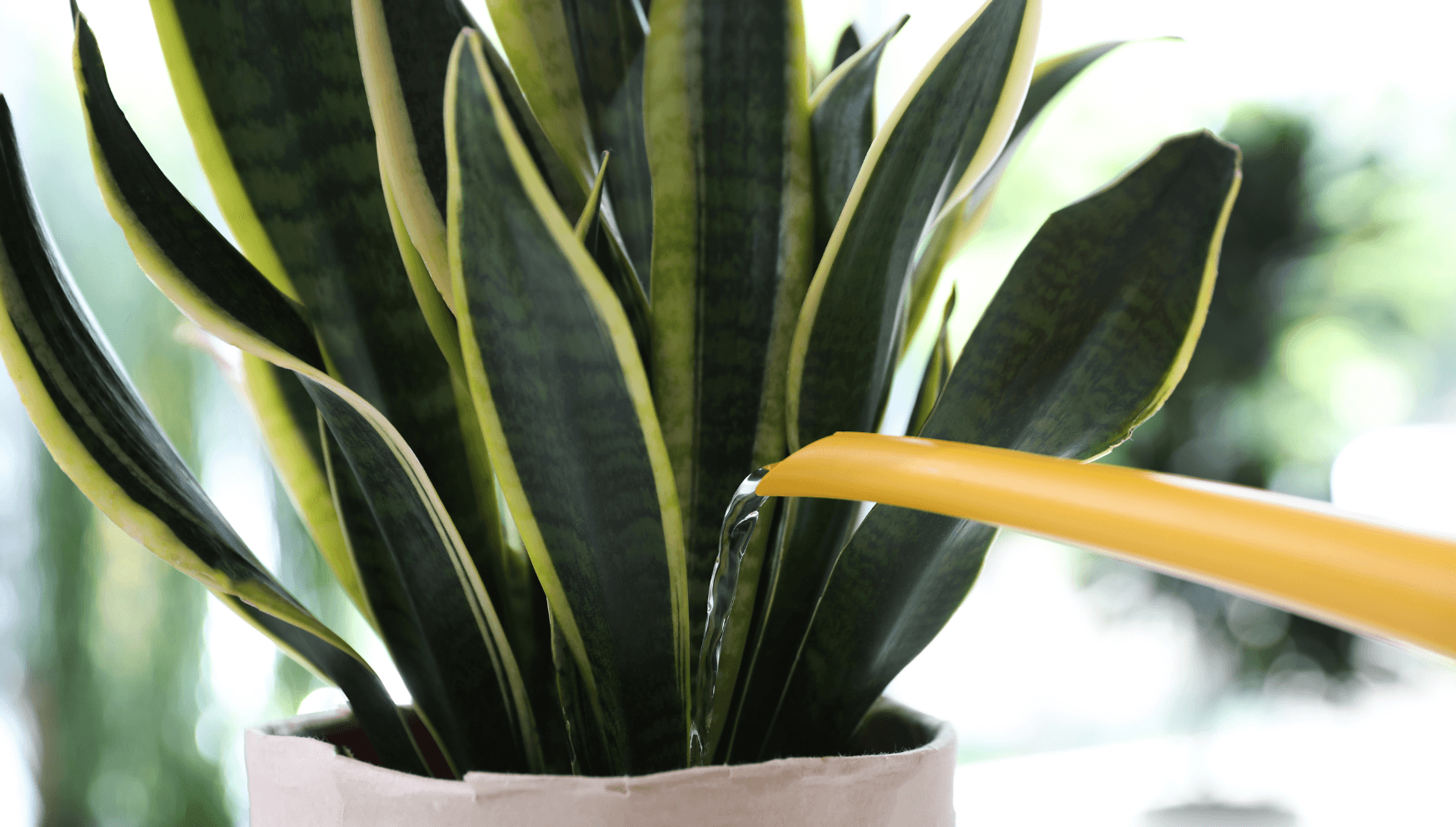
Symptoms of overwatering include yellow leaves and soft stems near the soil's surface. When root rot has already caused significant damage, the leaves can wrinkle, indicating thirst. Root rot damages plant roots and they can no longer take in water, and the plant is thirsty. In this case, the soil is clearly excessively moist and soggy.
Fertiliser
Snake Plants can survive without fertiliser, but if you want to give your plant a healthy boost, you can fertilise it once a month during the growing season (spring and summer). In winter and autumn, it is not necessary to add any extra nutrition at all.
Use PLNTS water-soluble liquid plant food made for houseplants. We recommend dilution to half strength to prevent over-fertilising.
Temperature
Snake Plants will tolerate a wide range of temperatures but grow best at 18-27°C. They are tough and can withstand temperatures as low as 10°C without damage. However, they will go dormant if temperatures fall below this, and their growth will slow down significantly.
Is it safe to take it outside in the summer (Europe)?
When it comes to temperature, they could be taken outside, but you'll need to keep them under a roof, protected from the sun and rain. The leaves are tubular at the bottom, so rainwater can easily collect and cause them to rot quickly. Also, the direct and intensive sun can scorch their leaves.
Humidity
Snake Plants are relatively tolerant of a wide range of humidity levels and do not require high humidity. They are tough, desert-dwelling plants that are adapted to dry conditions. They will grow well in average room humidity, typically around 40-60%. But can also tolerate low humidity levels, as low as 20%, without any damage.
Repotting
Snake Plants grow slowly, so they typically do not need to be repotted very often. On average, you will need to repot your Snake Plants every 2-3 years or whenever it outgrows its current pot. Here are our best tips for repotting houseplants. Snake Plants like to be a little root-bound, so don’t plant it in a too big pot or too often.
Soil
Since the Snake Plants are relatively sensitive to overwatering, we recommend choosing well-draining soil. The airy soil for cacti and succulents is great. In too rich soil, they can grow too lush, but at the same time, the leaves remain weak and not so beautiful.
Snake Plants have no particular preference for soil pH ranges, but they do best in soils with a pH from 6.0 to 7.5.
Snake Plant Propagation
Sansevieria plants are easy to propagate, so you can quickly grow them for your house or to share them with friends! There are two ways to propagate Snake Plants - you can cut off leaves and let them root in water or soil, or you can divide its shoots. You can propagate them at any time of the year.
Step-by-step guide on how to propagate by leaf cuttings:
- Choose a healthy mother plant with plenty of leaves so that you can cut away one or two leaves.
- Cut a leaf from the parent plant using a clean, sharp knife or scissors. If you have a larger leaf, it can be cut into several smaller parts - each part will grow roots under it!
- Make an inverted V-cut at the bottom of the leaf part. This helps to increase the surface area for plants to take more water and nutrients and therefore allows the propagation process. It isn't necessary, however.
- Dip the bottom of the cutting into rooting powder to encourage the propagation process.
- Place the leaf or leaf part in a clean pot with water or well-draining soil, and place your cutting in a bright, indirect light location and away from direct sunlight.
- When rooting in water, change the water periodically, and if it's in soil, just water it regularly.
In a few weeks, you should see new growth from the base of the leaf, indicating that the propagation has been successful. It will grow a new plant from the bottom of the leaf part. This leaf part itself won't grow any bigger. When your baby Snake Plant has grown bigger, transplant it into a pot with well-draining soil.
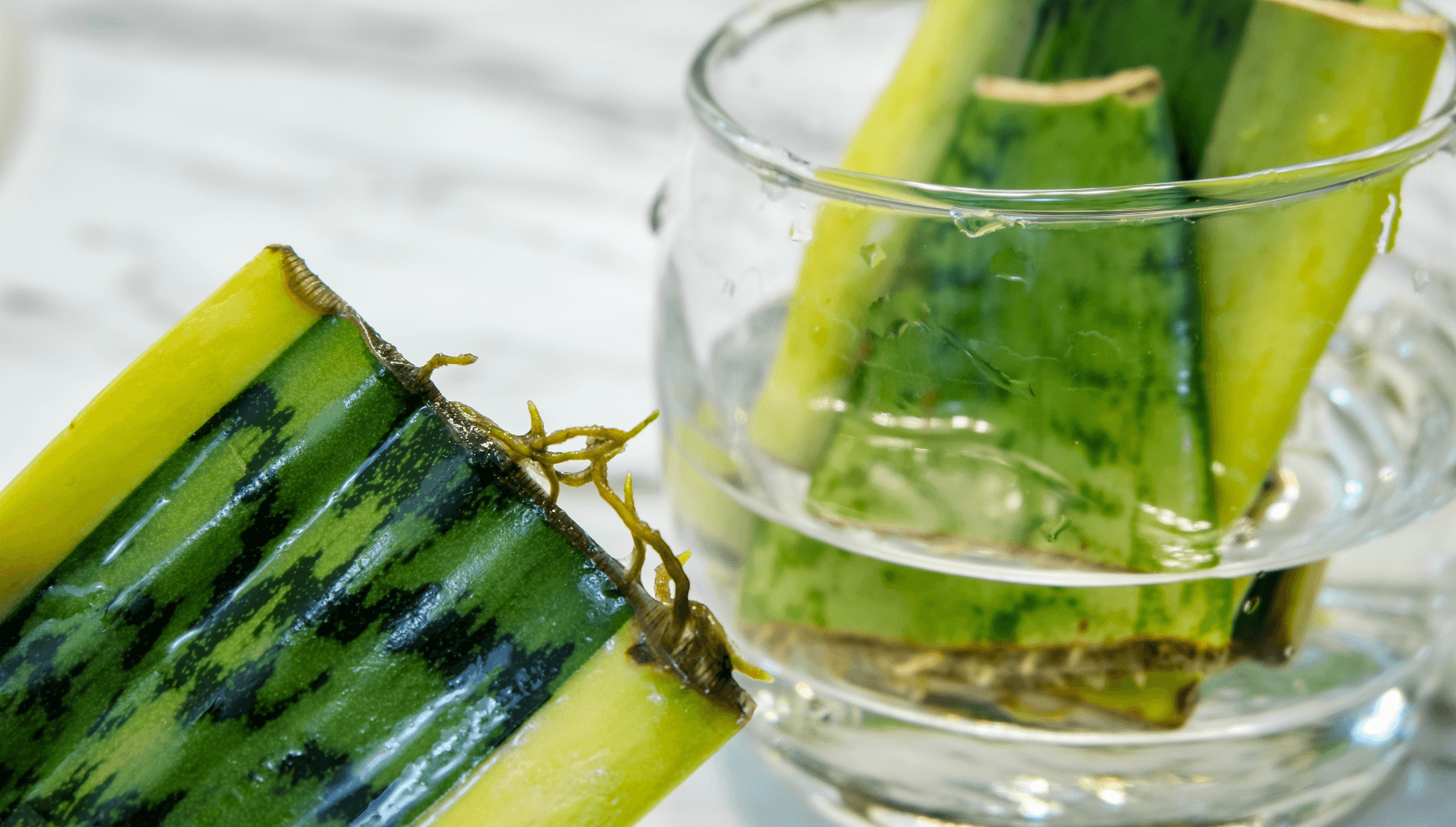
A step-by-step guide to propagating Snake Plants by root division:
- For this method, you will need a Snake Plant with multiple shoots growing out of a pot. If you only have one stem from the pot, there’s nothing to divide.
- Gently remove the whole plant from its nursery pot. It can be helped to get out of the pot by tapping the sides and bottom.
- Locate the healthy and beautiful shoots you want to divide from the mother plant.
- Start by gently pulling them apart from a mother plant. If the roots are very tightly bound together, use a sharp knife to separate them.
- Fill several small pots with a well-draining cactus or succulent soil, and plant each division in its pot. Cover the roots properly with soil and ensure they are facing down.
- Water each pot lightly and place them in a bright, indirect light location away from direct sunlight.
In a few weeks, your new plant should develop new roots and even new growth. But remember that Snake Plant propagation can take time, depending on propagation and growing conditions. The darker and poorer conditions it takes root, the longer it may take.
Most common pests and diseases on Sansevieria
Snake Plant is almost never affected by diseases. If they do suffer from something, it will be aphids. If there is some aphid on the plant, it can easily be removed with a hard jet of water or with a damp cloth.
If the plant really suffers from a lot of pests, then it is advisable to combat these immediately. Check our PLNTS doctor page to find out which pests are bothering your plant and how you can best control them.
Snake Plant Frequenlty Asked Questions (FAQ)
Are Sansevierias toxic for pets or children?
Although the Sansevieria is little or non-toxic to humans, Sansevierias are considered poisonous to pets such as cats and dogs. When chewing or eating any part of these plants, humans and animals run the risk of developing a severe allergic reaction leading to swelling of the tissues in the oral cavity and oesophagus. Consuming the plant in significant quantities can even be fatal for your furry friend. So be alert when you see your pets or children with this plant.
How much light does a Snake Plant need?
Snake Plants need bright, indirect light to thrive, but they can also tolerate really low-light conditions. If you put your Snake Plant in a spot with no light, it will survive there sometime but eventually (and slowly) will die.
How long can Snake Plants go without water?
Snake Plants are drought-tolerant and can go for several weeks to several months without water, depending on growing conditions.
What are the signs of an overwatered or underwatered Snake Plant?
An overwatered Snake Plant will show signs of yellowing and mushy leaves, while an underwatered Snake Plant will have dry, crispy leaves. Usually, you’ll understand if you touch the soil - if the soil is ash dry and you haven't watered it in several months, it may suffer underwater. However, if the soil is wet, moist or soggy and you’ve watered it in the recent past, it probably suffers under overwatering.
Can I water my Snake Plant with tap water?
Yes, you can. Snake Plants are not known for being sensitive to tap water. If you suspect your tap water might contain something bad for your Sansevieria, you may need to use filtered water or wait another 24 hours before watering. However, this depends on the quality of your tap water.
Can I trim my Snake Plant's leaves?
Trimming the leaves of your Snake Plant is okay and can help control its height. Simply cut the leaves at the base, near the soil surface. Also, you can prune all damaged (yellow or brown) leaves to keep them looking beautiful and healthy.
Do Snake Plant flowers? How to get it to bloom?
Snake Plants produce small, tubular flowers on tall spikes but rarely bloom indoors. To encourage blooming, they need bright, indirect light, a cool period of temperature, and to be slightly under-watered during this time.
Flowers often go unnoticed by plant parents because they are hidden among the leaves. However, at night these flowers begin to smell very pleasant and attract your attention.
Buy your new Sansevieria at PLNTS.com
At PLNTS.com you can buy your new Sansevieria online, for example the Sansevieria Mikado. Whether you like your PLNTS big from the start or prefer to grow them from tiny BabyPLNTS into full-grown PLNTS - buy Sansevieria online at PLNTS.com!


